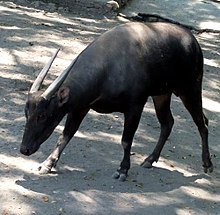BUBALUS (ANOA)
CLASSIFICATION
| Kingdom: | |||||||
| Phylum: | |||||||
| Class: | |||||||
| Order: | |||||||
| Family: | |||||||
| Subfamily: | |||||||
| Genus: | |||||||
| Species: |
B. depressicornis
|
______________________________________________________________________
Anoa, also known as midget buffalo and sapiutan, are a subgenus of Bubalus comprising two species endemic to the island of Sulawesi in Indonesia: the mountain anoa (Bubalus quarlesi) and the lowland anoa (Bubalus depressicornis). Both live in undisturbed rainforest and are similar in appearance to miniature water buffalo, weighing 150–300 kg (330–660 lb). Both species of anoa have been classified as endangered since the 1960s and the populations continue to decrease. Fewer than 5,000 animals of each species likely remain. Reasons for their decline include hunting for hides, horns and meat by the local peoples and loss of habitat due to the advancement of settlement. Currently, hunting is the more serious factor in most areas. After a study of the skulls of many anoa, it was shown that there was hybridizing and interbreeding between the two. It was questioned as to whether the two species were actually different due to mixing of the two in many different areas, as well as some interbreeding. After analyzing the DNA of the two, it was proven that they are in fact different species. _______________________________________________________________________ HabitatBoth the lowland anoa (Bubalus depressicornis) and the mountain anoa (Bubalus quarlesi) are endemic to the islands of Sulawesi in Indonesia. Sulawesi is a unique area due to the fact that roughly 61% of the species found there are endemic species, including the anoa. The key difference between the two species is the areas of habitat that is utilized on the islands. The mountain anoa is found at higher elevations than its lowland counterpart and is found in the forested mountainous regions. The lowland anoa spends its time in the lower elevation areas and is also found in core habitat of forested area. The habitat needs of both species can have some overlap and oftentimes the two species are found in the same area. The key factor to where they are found is core forested habitat away from humans._______________________________________________________________________ MorphologyThe anoa have many physical characteristics of bovine relatives and are considered to be most closely related to the water buffalo, which was confirmed through DNA analysis. However, some scientists believe they may be more closely related to the Asian antelope. All anoa vary in appearance, but have the same standard characters.The two species diverged due to a difference in elevation and a slight change in habitat from the latter, but their physical characteristics remain similar. The anoa is the smallest of the wild cattle species. When anoa are born, they have a set of thick, woolly fur that comes in many color variations ranging from yellow to brown. In adults, the fur is typically brown or black and males tend to have darker variations. Hair thickness varies slightly between the two species based on elevation and distribution. In both species of anoa, horns are present on both males and females and are typically straight protuberances. Another defining characteristic of the anoa is an extremely thick hide underneath the thick fur. _______________________________________________________________________ ConservationThe anoa are endemic to the island of Sulawesi and are currently experiencing large declines in their populations. Knowledge of their decline has only recently been documented, however, and the villages and villagers lack the knowledge of how to help maintain or increase populations.The leading cause of their population decline is, in fact, hunting by the local villagers and not having restrictions or proper management strategies.[citation needed] The one benefit is that villagers are open to communication with researchers on their harvests and hunting practices. The second leading cause of population decline is habitat loss and in the region of Tangkoko the anoa are actually extirpated. Logging is a large issue due to the fact that both species prefer core forested habitat that is far away from humans and the influences that come with them. By logging, humans create much more fragmented habitat and, therefore, a decrease in the area where the anoa can breed and live. This habitat fragmentation also alters the natural mixing of populations of the anoa. This may lead to a loss in genetic diversity between the two species and, over time, could also lead to their decline. POWER POINT BUBALUS power point after edit
Questions :
|

Tidak ada komentar:
Posting Komentar